Spatiotemporal Patterns of Ecosystem Service Value Changes and Their Coordination with Economic Development: A Case Study of the Yellow River Basin, China
Abstract
1. Introduction
2. Study Area
3. Materials and Methods
3.1. Data Collection
3.2. Valuation of ESV
3.3. Theil-Sen Median Trend Analysis and Mann-Kendall Test
3.4. Stability and Continuity Model
3.5. Ecological-Economic Coordination Level Model
4. Results
4.1. Spatial Pattern and Spatiotemporal Trends of ESVs
4.1.1. Distribution Pattern of ESVs in the Yellow River Basin
4.1.2. Spatiotemporal Analysis of the ESVs in the Yellow River Basin
4.1.3. Stability and Continuity of the ESV in the Yellow River Basin
4.2. Spatial Pattern of Coordinated Ecological-Economic Development in the Yellow River Basin
5. Discussion
6. Conclusions
- (1)
- From 2001 to 2015, the total ESV and ESV per unit area in the Yellow River Basin showed a weak decline followed by a rapid increase. The total ESV increased by 23% in 15 years. The ESV per unit area increased to 82.35 × 104 yuan/km2. Qinghai and Sichuan showed decreases in ESV per unit area. The other seven provincial regions all showed increases. The spatial distribution of ESVs showed high values in the west and southeast and low values in the north. In most areas of the Loess Plateau, effective comprehensive management has significantly improved the ESV.
- (2)
- From 2000 to 2015, the spatiotemporal ESV trend in the Yellow River Basin was directional, clustered, and differentiated. The total area showing an upward ESV trend accounted for approximately 55.6% of the river basin’s total area, with the central area of the Loess Plateau as the focal area. The areas showing a downward trend were mainly concentrated in the Yellow River Basin’s western and northern regions. Unsustainable human development activities were the main reason for the significant decline in the ESV.
- (3)
- There were significant spatial and regional differences in ESV’s stability and continuity in the Yellow River Basin, which showed a clustered, compact distribution. The areas of continuous steady decline, continuous steady increase, and continuous unsteady increase made up the largest proportions of the river basin’s total area. Other types were sporadic. The future ecological plans should focus on areas of continuous steady decline, reinforce areas of continuous steady increase, and control areas of noncontinuous steady increase and areas of noncontinuous unsteady increase.
- (4)
- The level of EEC in the Yellow River Basin was dominated by slightly uncoordinated areas, followed by slightly coordinated and highly coordinated areas. The slightly uncoordinated areas were 47.1% of the study area, and the slightly coordinated areas accounted for approximately 25.6% of the study area. The distribution of highly coordinated areas was Q-shaped, mainly distributed in the Yellow River’s lower reaches, Qinling Mountains, and Guanzhong Basin. The level of EEC varied between land use types. The proportion of all types of coordinated areas in the cultivated land area was 98.8%. In built-up land, the proportion of uncoordinated areas was 99.1%.
Author Contributions
Funding
Conflicts of Interest
References
- Polasky, S.; Kling, C.L.; Levin, S.A.; Carpenter, S.R.; Daily, G.C.; Ehrlich, P.R.; Heal, G.M.; Lubchenco, J. Role of economics in analyzing the environment and sustainable development. Proc. Nat. Acad. Sci. 2019, 116, 5233–5238. [Google Scholar] [CrossRef]
- Braat, L.C.; De Groot, R. The ecosystem services agenda:bridging the worlds of natural science and economics, conservation and development, and public and private policy. Ecosyst. Serv. 2012, 1, 4–15. [Google Scholar] [CrossRef]
- Huq, N.; Bruns, A.; Ribbe, L. Interactions between freshwater ecosystem services and land cover changes in southern Bangladesh: A perspective from short-term (seasonal) and long-term (1973–2014) scale. Sci. Tot. Environ. 2019, 650, 132–143. [Google Scholar] [CrossRef] [PubMed]
- Norgaard, R.B. Ecosystem services: From eye-opening metaphor to complexity blinder. Ecol. Econ. 2010, 69, 1219–1227. [Google Scholar] [CrossRef]
- Daily, G.C.; Soderqvist, T.; Aniyar, S.; Arrow, K.J.; Dasgupta, P.; Ehrlich, P.R.; Folke, C.; Jansson, A.; Jansson, B.O.; Kautsky, N. The Value of Nature and the Nature of Value. Science 2000, 289, 395–396. [Google Scholar] [CrossRef] [PubMed]
- Sun, X.; Li, F. Spatiotemporal assessment and trade-offs of multiple ecosystem services based on land use changes in Zengcheng, China. Sci. Total. Environ. 2017, 609, 1569–1581. [Google Scholar] [CrossRef] [PubMed]
- Kreuter, U.P.; Harris, H.G.; Matlock, M.D.; E Lacey, R. Change in ecosystem service values in the San Antonio area, Texas. Ecol. Econ. 2001, 39, 333–346. [Google Scholar] [CrossRef]
- Mancini, M.S.; Galli, A.; Niccolucci, V.; Lin, D.; Hanscom, L.; Wackernagel, M.; Bastianoni, S.; Marchettini, N. Stocks and flows of natural capital: Implications for Ecological Footprint. Ecol. Indic. 2017, 77, 123–128. [Google Scholar] [CrossRef]
- Ouyang, Z.; Zheng, H.; Xiao, Y.; Polasky, S.; Liu, J.; Xu, W.; Wang, Q.; Zhang, L.; Rao, E.; Jiang, L.; et al. Improvements in ecosystem services from investments in natural capital. Science 2016, 352, 1455–1459. [Google Scholar] [CrossRef]
- Diaz, S.M.; Pascual, U.; Stenseke, M.; Martín-López, B.; Watson, R.T.; Molnár, Z.; Hill, R.; Chan, K.M.A.; Baste, I.A.; Brauman, K.A.; et al. Assessing nature’s contributions to people. Science 2018, 359, 270–272. [Google Scholar] [CrossRef]
- Zhang, Q.; Wang, L.; Wu, F.; Yuan, L.; Zhao, L. Quantitative Evaluation for Coupling Coordinated Development between Ecosystem and Economic System—Case Study of Chinese Loess Plateau. J. Urban Plan. Dev. 2012, 138, 328–334. [Google Scholar] [CrossRef]
- Scalia, M.; Angelini, A.; Farioli, F.; Mattioli, G.F.; Ragnisco, O.; Saviano, M. An Ecology and Economy Coupling Model. A global stationary state model for a sustainable economy in the Hamiltonian formalism. Ecol. Econ. 2020, 172, 106497. [Google Scholar] [CrossRef]
- Anderies, J.M.; Janssen, M.A.; Ostrom, E. A Framework to Analyze the Robustness of Social-ecological Systems from an Institutional Perspective. Ecol. Soc. 2004, 9, 18. [Google Scholar] [CrossRef]
- Chen, T.; Peng, L.; Wang, Q.; Liu, S.-Q. Measuring the Coordinated Development of Ecological and Economic Systems in Hengduan Mountain Area. Sustainability 2017, 9, 1270. [Google Scholar] [CrossRef]
- Wang, Z.; Fang, C.; Cheng, S.; Wang, J. Evolution of coordination degree of eco-economic system and early-warning in the Yangtze River Delta. J. Geogr. Sci. 2013, 23, 147–162. [Google Scholar] [CrossRef]
- Holdren, J.P.; Ehrlich, P.R. Human population and the global environment. Am. Sci. 1974, 62, 282–292. [Google Scholar] [PubMed]
- Westman, W.E. How Much Are Nature’s Services Worth? Science 1977, 197, 960–964. [Google Scholar] [CrossRef]
- Costanza, R.; D’Arge, R.; De Groot, R.; Farber, S.; Grasso, M.; Hannon, B.; Limburg, K.; Naeem, S.; O’Neill, R.V.; Paruelo, J.; et al. The value of the world’s ecosystem services and natural capital. Nat. Cell Biol. 1997, 387, 253–260. [Google Scholar] [CrossRef]
- Costanza, R.; De Groot, R.; Braat, L.; Kubiszewski, I.; Fioramonti, L.; Sutton, P.C.; Farber, S.; Grasso, M. Twenty years of ecosystem services: How far have we come and how far do we still need to go? Ecosyst. Serv. 2017, 28, 1–16. [Google Scholar] [CrossRef]
- Costanza, R.; De Groot, R.; Sutton, P.C.; Van Der Ploeg, S.; Anderson, S.J.; Kubiszewski, I.; Farber, S.; Turner, R.K. Changes in the global value of ecosystem services. Glob. Environ. Chang. 2014, 26, 152–158. [Google Scholar] [CrossRef]
- De Groot, R.; Brander, L.; Van Der Ploeg, S.; Costanza, R.; Bernard, F.; Braat, L.; A Christie, M.; Crossman, N.; Ghermandi, A.; Hein, L.; et al. Global estimates of the value of ecosystems and their services in monetary units. Ecosyst. Serv. 2012, 1, 50–61. [Google Scholar] [CrossRef]
- Xie, G.; Zhang, C.; Zhen, L.; Zhang, L. Dynamic changes in the value of China’s ecosystem services. Ecosyst. Serv. 2017, 26, 146–154. [Google Scholar] [CrossRef]
- Pan, J.; Wei, S.; Li, Z. Spatiotemporal pattern of trade-offs and synergistic relationships among multiple ecosystem services in an arid inland river basin in NW China. Ecol. Indic. 2020, 114, 106345. [Google Scholar] [CrossRef]
- Chisholm, R.A. Trade-offs between ecosystem services: Water and carbon in a biodiversity hotspot. Ecol. Econ. 2010, 69, 1973–1987. [Google Scholar] [CrossRef]
- Niu, X.; Wang, B.; Liu, S.; Liu, C.; Wei, W.; Kauppi, P.E. Economical assessment of forest ecosystem services in China: Characteristics and implications. Ecol. Complex. 2012, 11, 1–11. [Google Scholar] [CrossRef]
- Zhang, D.; Min, Q.; Liu, M.; Cheng, S. Ecosystem service tradeoff between traditional and modern agriculture: A case study in Congjiang County, Guizhou Province, China. Front. Environ. Sci. Eng. 2012, 6, 743–752. [Google Scholar] [CrossRef]
- Liu, Y.; Li, J.; Zhang, H. An ecosystem service valuation of land use change in Taiyuan City, China. Ecol. Model. 2012, 225, 127–132. [Google Scholar] [CrossRef]
- Tianhong, L.; Wenkai, L.; Zhenghan, Q. Variations in ecosystem service value in response to land use changes in Shenzhen. Ecol. Econ. 2010, 69, 1427–1435. [Google Scholar] [CrossRef]
- Zhao, B.; Kreuter, U.; Li, B.; Ma, Z.; Chen, J.; Nakagoshi, N. An ecosystem service value assessment of land-use change on Chongming Island, China. Land Use Policy 2004, 21, 139–148. [Google Scholar] [CrossRef]
- Wu, B.; Zhaoyin, W.; Changzhi, L. Yellow River Basin management and current issues. J. Geogr. Sci. 2004, 14, 29–37. [Google Scholar] [CrossRef]
- Zhao, D.; Kuenzer, C.; Fu, C.; Wagner, W. Evaluation of the ERS Scatterometer-Derived Soil Water Index to Monitor Water Availability and Precipitation Distribution at Three Different Scales in China. J. Hydrometeorol. 2008, 9, 549–562. [Google Scholar] [CrossRef]
- Yuan, M.; Zhao, L.; Lin, A.; Li, Q.; She, D.; Qu, S. How do climatic and non-climatic factors contribute to the dynamics of vegetation autumn phenology in the Yellow River Basin, China? Ecol. Indic. 2020, 112, 106112. [Google Scholar] [CrossRef]
- Xi, J. Speech at the Symposium on Ecological Protection and High-Quality Development of Yellow River Basin. Available online: http://www.qstheory.cn/dukan/qs/2019-10/15/c_1125102357.htm (accessed on 11 November 2020). (In Chinese).
- Di, D.; Wu, Z.; Guo, X.; Lv, C.; Wang, H. Value Stream Analysis and Emergy Evaluation of the Water Resource Eco-Economic System in the Yellow River Basin. Water 2019, 11, 710. [Google Scholar] [CrossRef]
- Geospatial Data Cloud. Available online: http://www.gscloud.cn/ (accessed on 1 October 2019). (In Chinese).
- Numerical Terradynamic Simulation Group, College of Forestry & Conservation, University of Montana. Available online: http://files.ntsg.umt.edu/data/%20NTSG_Products/MOD17/GeoTIFF/MOD17A3/GeoTIFFarcsec/ (accessed on 5 October 2019).
- Data Center for Resources and Environmental Sciences of the Chinese Academy of Sciences. Available online: http://www.resdc.cn (accessed on 10 October 2019). (In Chinese).
- Xie, G.; Lin, Z.; Chunxia, L.; Wenhua, L. Applying Value Transfer Method for Eco-Service Valuation in China. Journal of Resources and Ecology 2010, 1. [Google Scholar] [CrossRef]
- Zhang, F.; Yushanjiang, A.; Jing, Y. Assessing and predicting changes of the ecosystem service values based on land use/cover change in Ebinur Lake Wetland National Nature Reserve, Xinjiang, China. Sci. Total. Environ. 2019, 656, 1133–1144. [Google Scholar] [CrossRef] [PubMed]
- Gong, Z.; Zhao, S.; Gu, J. Correlation analysis between vegetation coverage and climate drought conditions in North China during 2001–2013. J. Geogr. Sci. 2017, 27, 143–160. [Google Scholar] [CrossRef]
- Jiang, W.; Yuan, L.; Wang, W.; Cao, R.; Zhang, Y.; Shen, W. Spatio-temporal analysis of vegetation variation in the Yellow River Basin. Ecol. Indic. 2015, 51, 117–126. [Google Scholar] [CrossRef]
- Fensholt, R.; Proud, S.R. Evaluation of Earth Observation based global long term vegetation trends—Comparing GIMMS and MODIS global NDVI time series. Remote. Sens. Environ. 2012, 119, 131–147. [Google Scholar] [CrossRef]
- Lunetta, R.S.; Knight, J.F.; Ediriwickrema, J.; Lyon, J.G.; Worthy, L.D. Land-cover change detection using multi-temporal MODIS NDVI data. Remote. Sens. Environ. 2006, 105, 142–154. [Google Scholar] [CrossRef]
- Fensholt, R.; Rasmussen, K.; Nielsen, T.T.; Mbow, C. Evaluation of earth observation based long term vegetation trends — Intercomparing NDVI time series trend analysis consistency of Sahel from AVHRR GIMMS, Terra MODIS and SPOT VGT data. Remote. Sens. Environ. 2009, 113, 1886–1898. [Google Scholar] [CrossRef]
- Tošić, I. Spatial and temporal variability of winter and summer precipitation over Serbia and Montenegro. Theor. Appl. Clim. 2004, 77, 47–56. [Google Scholar] [CrossRef]
- Tucker, C.J.; Newcomb, W.W.; Los, S.O.; Prince, S.D. Mean and inter-year variation of growing-season normalized difference vegetation index for the Sahel 1981–1989. Int. J. Remote. Sens. 1991, 12, 1133–1135. [Google Scholar] [CrossRef]
- Milich, L.; Weiss, E. GAC NDVI interannual coefficient of variation (CoV) images: Ground truth sampling of the Sahel along north-south transects. Int. J. Remote Sens. 2000, 21, 235–260. [Google Scholar] [CrossRef]
- Na, F. Spatial-Temporal Dynamic Changes of Vegetation Cover in Lancang River Basin during 2001-2010. Resources Science 2012, 34, 1222–1231. (In Chinese) [Google Scholar]
- Hou, X.; Wu, T.; Yu, L.; Qian, S. Characteristics of multi-temporal scale variation of vegetation coverage in the Circum Bohai Bay Region, 1999–2009. Acta Ecol. Sin. 2012, 32, 297–304. [Google Scholar] [CrossRef]
- Granero, M.S.; Segovia, J.T.; Pérez, J.G. Some comments on Hurst exponent and the long memory processes on capital markets. Phys. A: Stat. Mech. its Appl. 2008, 387, 5543–5551. [Google Scholar] [CrossRef]
- Zhao, H.; He, H.; Bai, C.; Zhang, C. Spatial-temporal characteristics of land use change in the loess plateau and its environmental effects. China Land Sci. 2018, 32, 49–57. (In Chinese) [Google Scholar]
- Qian, D.; Yan, C.Z.; Xiu, L.; Feng, K. The impact of mining changes on surrounding lands and ecosystem service value in the Southern Slope of Qilian Mountains. Ecol. Complex. 2018, 36, 138–148. [Google Scholar] [CrossRef]
- Sawut, M.; Eziz, M.; Tiyip, T. The effects of land-use change on ecosystem service value of desert oasis: A case study in Ugan-Kuqa River Delta Oasis, China. Can. J. Soil Sci. 2013, 93, 99–108. [Google Scholar] [CrossRef]
- Shi, L.; Cai, Z.; Ding, X.; Di, R.; Xiao, Q. What Factors Affect the Level of Green Urbanization in the Yellow River Basin in the Context of New-Type Urbanization? Sustainability 2020, 12, 2488. [Google Scholar] [CrossRef]
- Dong, F.; Pan, Y.; Zhang, X.; Sun, Z. How to Evaluate Provincial Ecological Civilization Construction? The Case of Jiangsu Province, China. Int. J. Environ. Res. Public Heal. 2020, 17, 5334. [Google Scholar] [CrossRef] [PubMed]
- Liang, D.; Xinchun, Y.; Shenglu, Z.; Hui, P.; Shaohua, W.; Qing, Z.; Hua, Z.; Haomin, Y. Land ecological assessment of Jintan city in Yangtze River Delta with highly developed economy. Trans. Chin. Soc. Agricult. Eng. 2013, 29, 249–257. (In Chinese) [Google Scholar]
- Li, Y.; Feng, Y.; Guo, X.; Peng, F. Changes in coastal city ecosystem service values based on land use—A case study of Yingkou, China. Land Use Policy 2017, 65, 287–293. [Google Scholar] [CrossRef]
- Li, Y.; Xie, Z.; Qin, Y.; Zheng, Z. Responses of the Yellow River basin vegetation: Climate change. Int. J. Clim. Chang. Strat. Manag. 2019, 11, 483–498. [Google Scholar] [CrossRef]
- Lin, S.; Jiang, Y.; He, J.; Ma, G.; Xu, Y.; Jiang, H. Changes in the spatial and temporal pattern of natural forest cover on Hainan Island from the 1950s to the 2010s: Implications for natural forest conservation and management. PeerJ 2017, 5, e3320. [Google Scholar] [CrossRef] [PubMed]
- Fang, Y. Managing the Three-Rivers Headwater Region, China: From Ecological Engineering to Social Engineering. AMBIO 2013, 42, 566–576. [Google Scholar] [CrossRef] [PubMed]
- Fu, B.; Liu, Y.; Lü, Y.; He, C.; Zeng, Y.; Wu, B. Assessing the soil erosion control service of ecosystems change in the Loess Plateau of China. Ecol. Complex. 2011, 8, 284–293. [Google Scholar] [CrossRef]
- Serban, A.C.; Aceleanu, M.I.; Saseanu, A.S. Constraints of Transition to Ecological Agriculture in a Sustainable development society. romanian perspective. Transform. Bus. Econ. 2017, 16, 56–72. [Google Scholar]
- Movono, A.; Dahles, H.; Becken, S. Fijian culture and the environment: A focus on the ecological and social interconnectedness of tourism development. J. Sustain. Tour. 2017, 26, 451–469. [Google Scholar] [CrossRef]
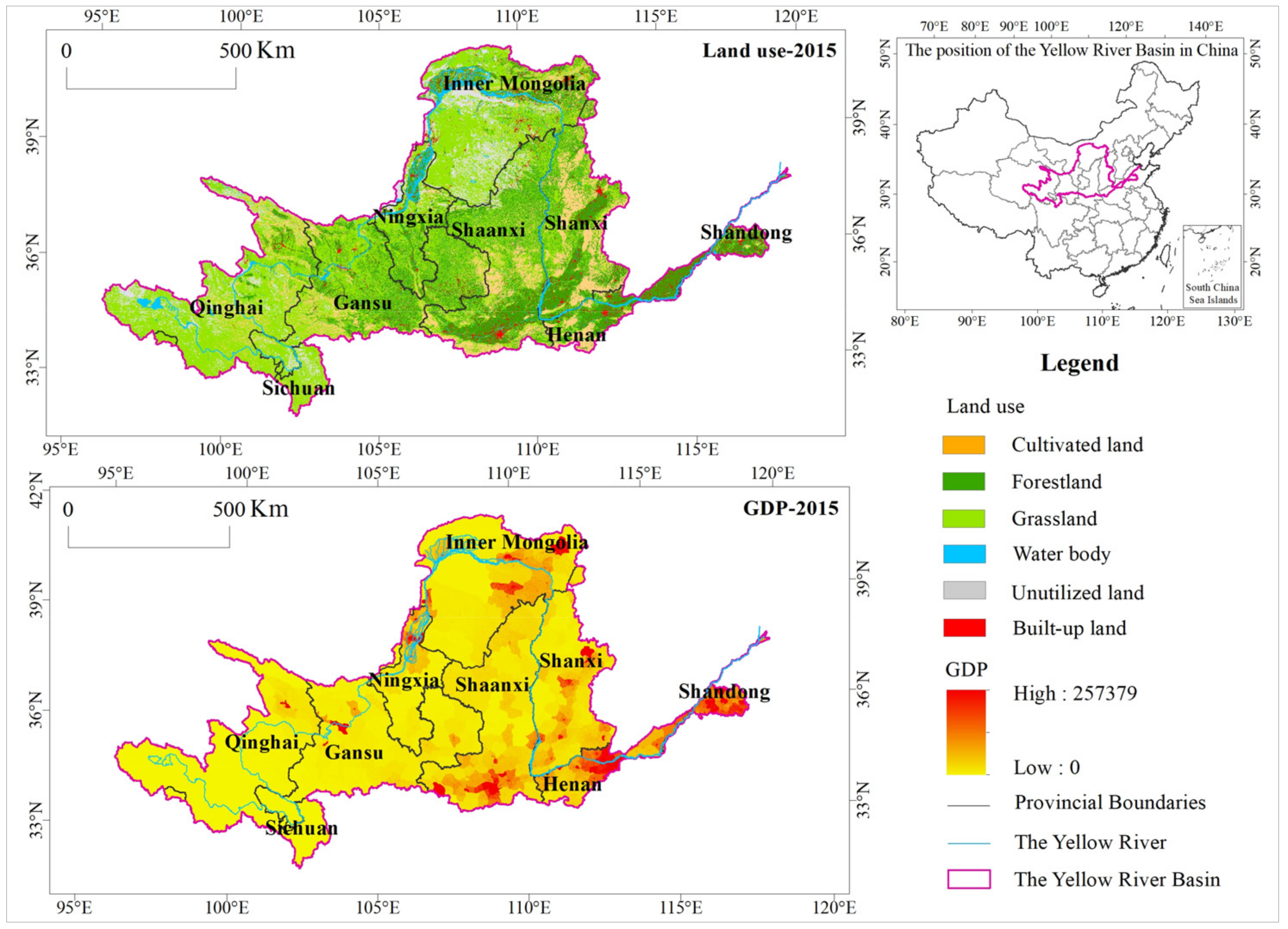
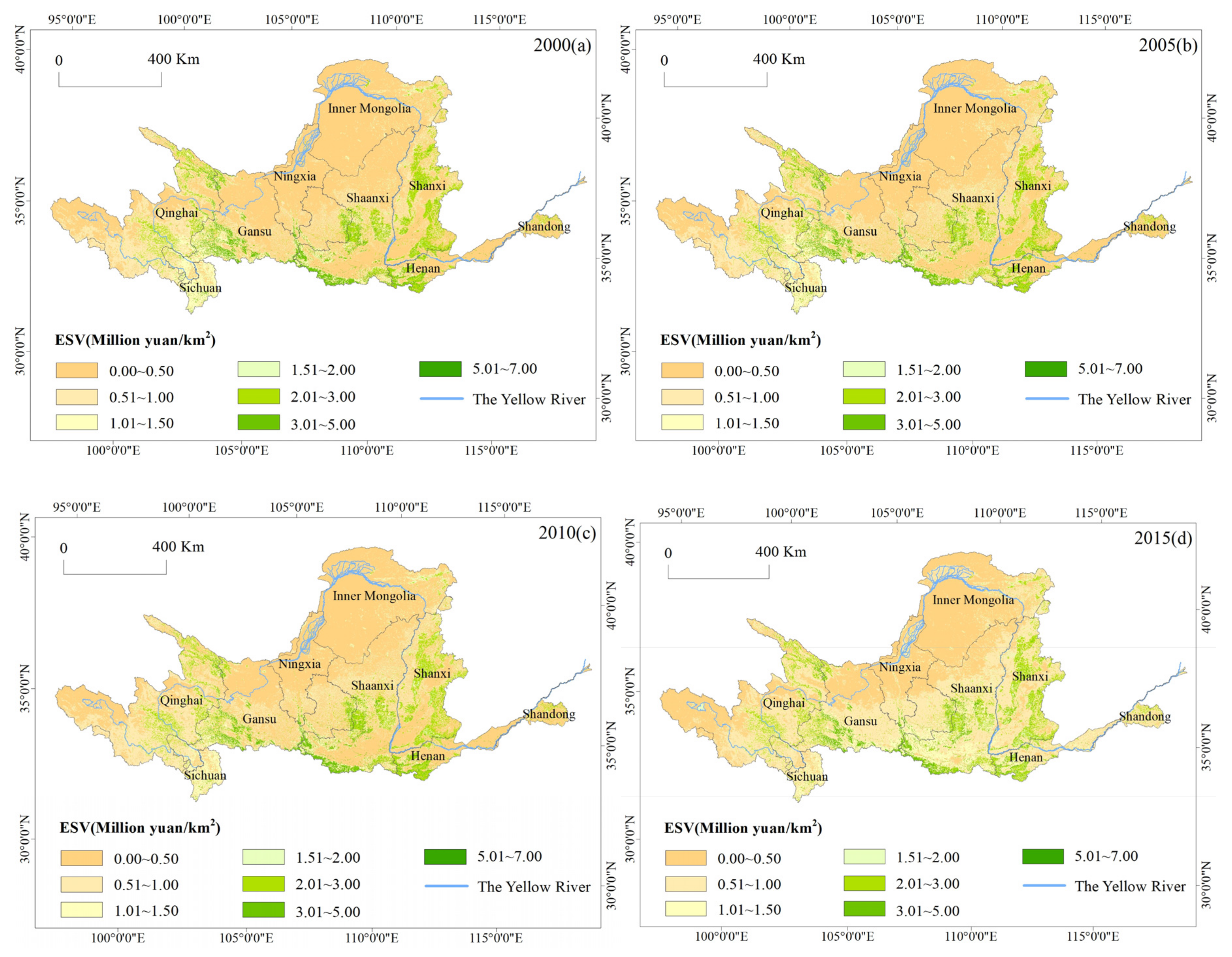
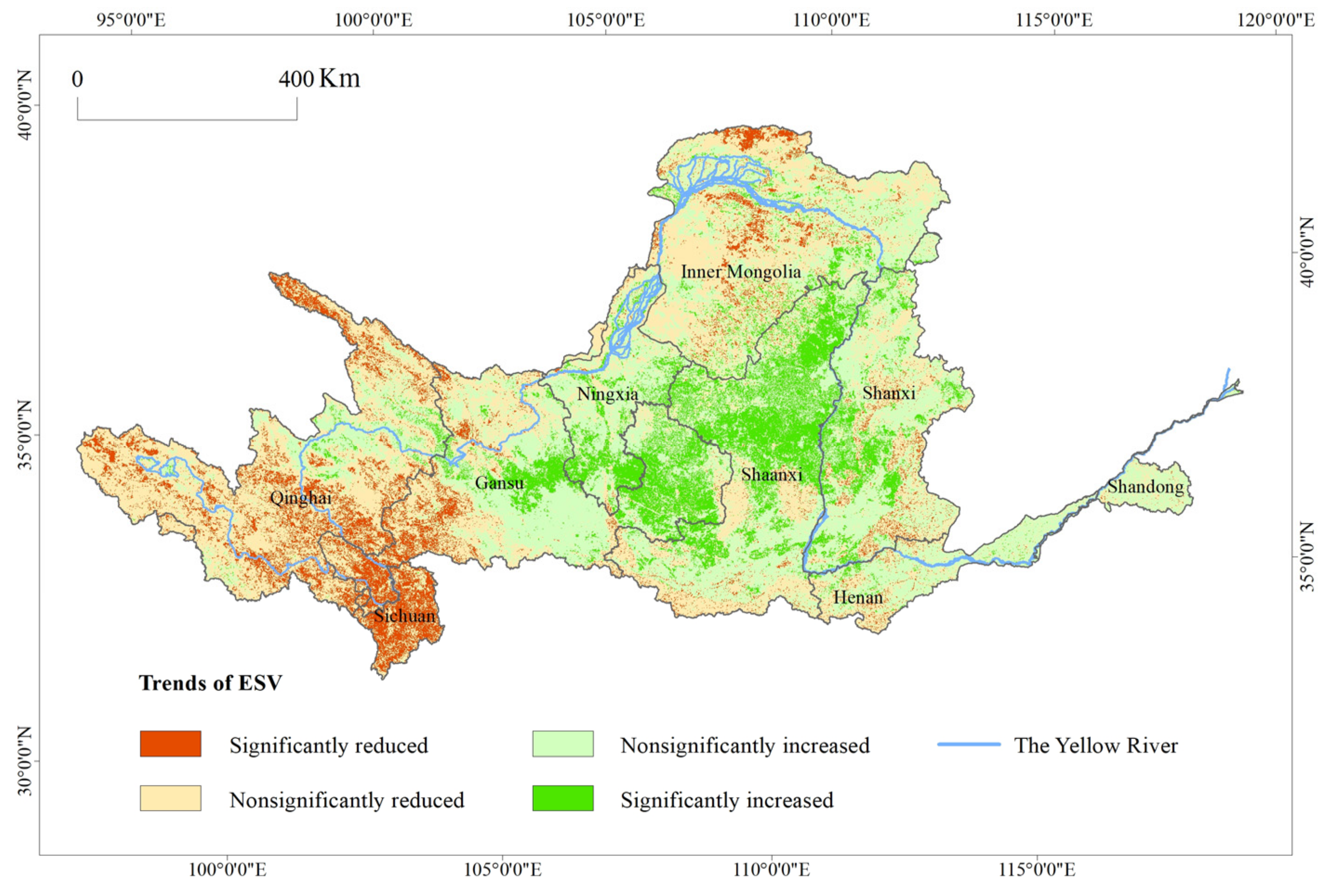
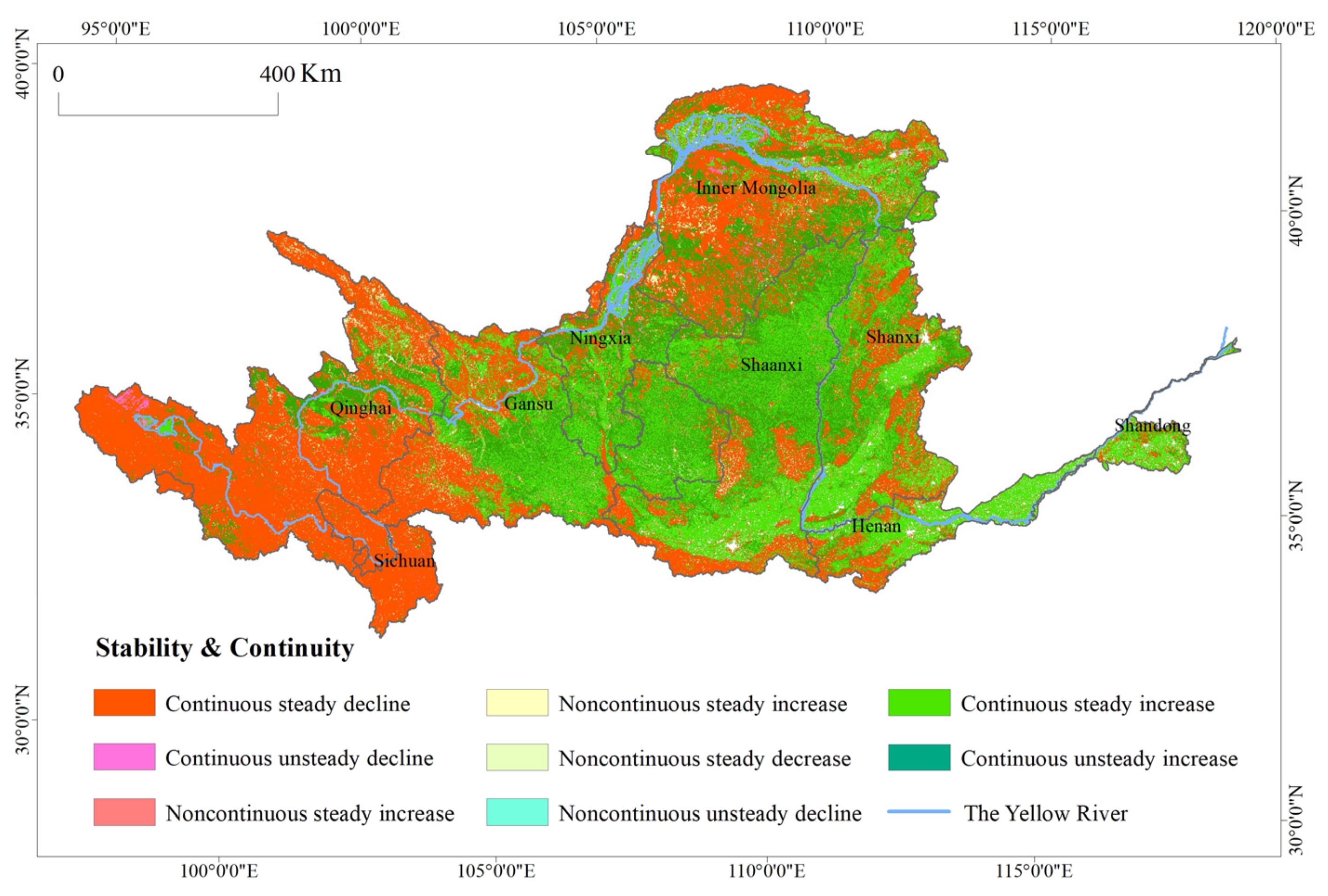
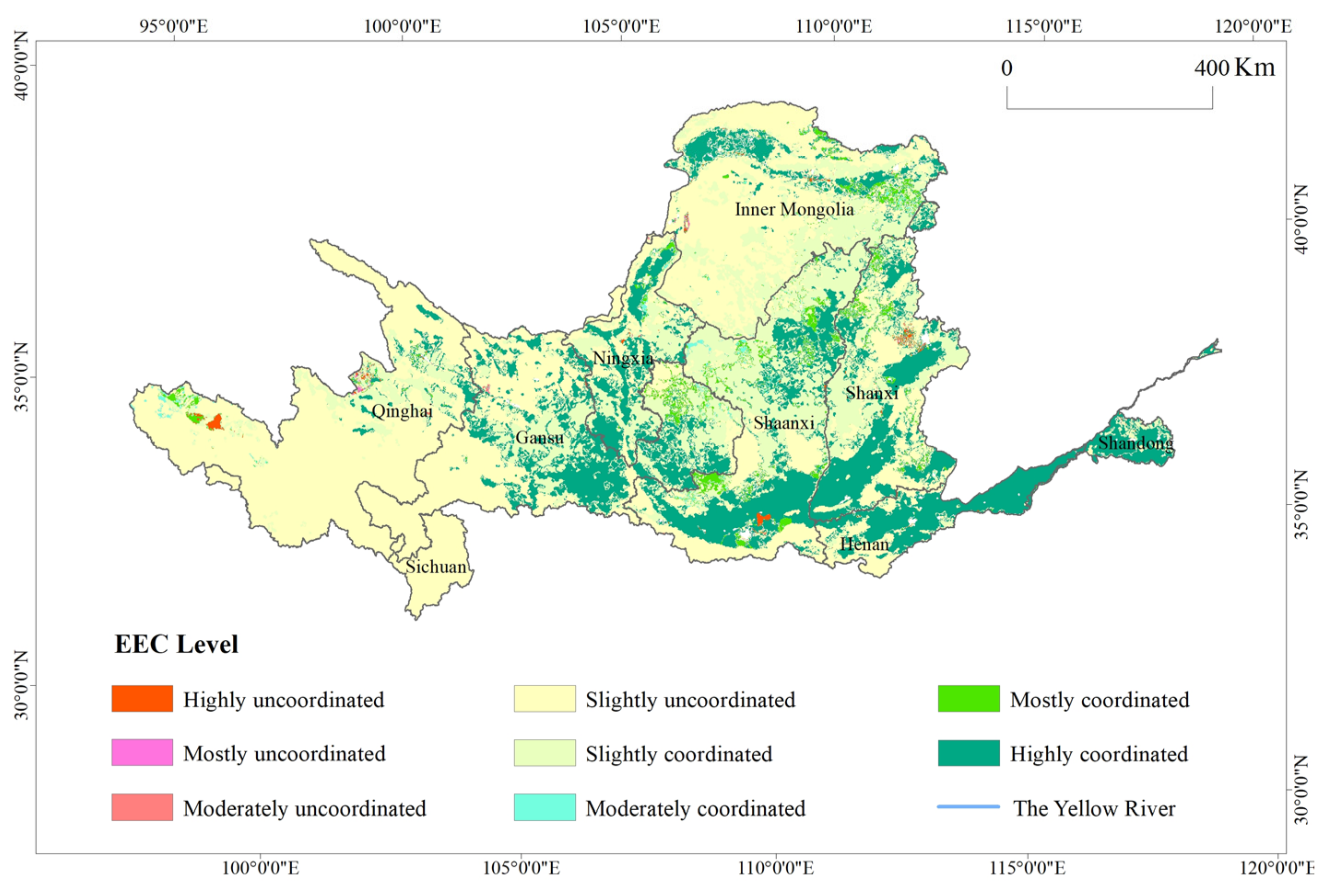
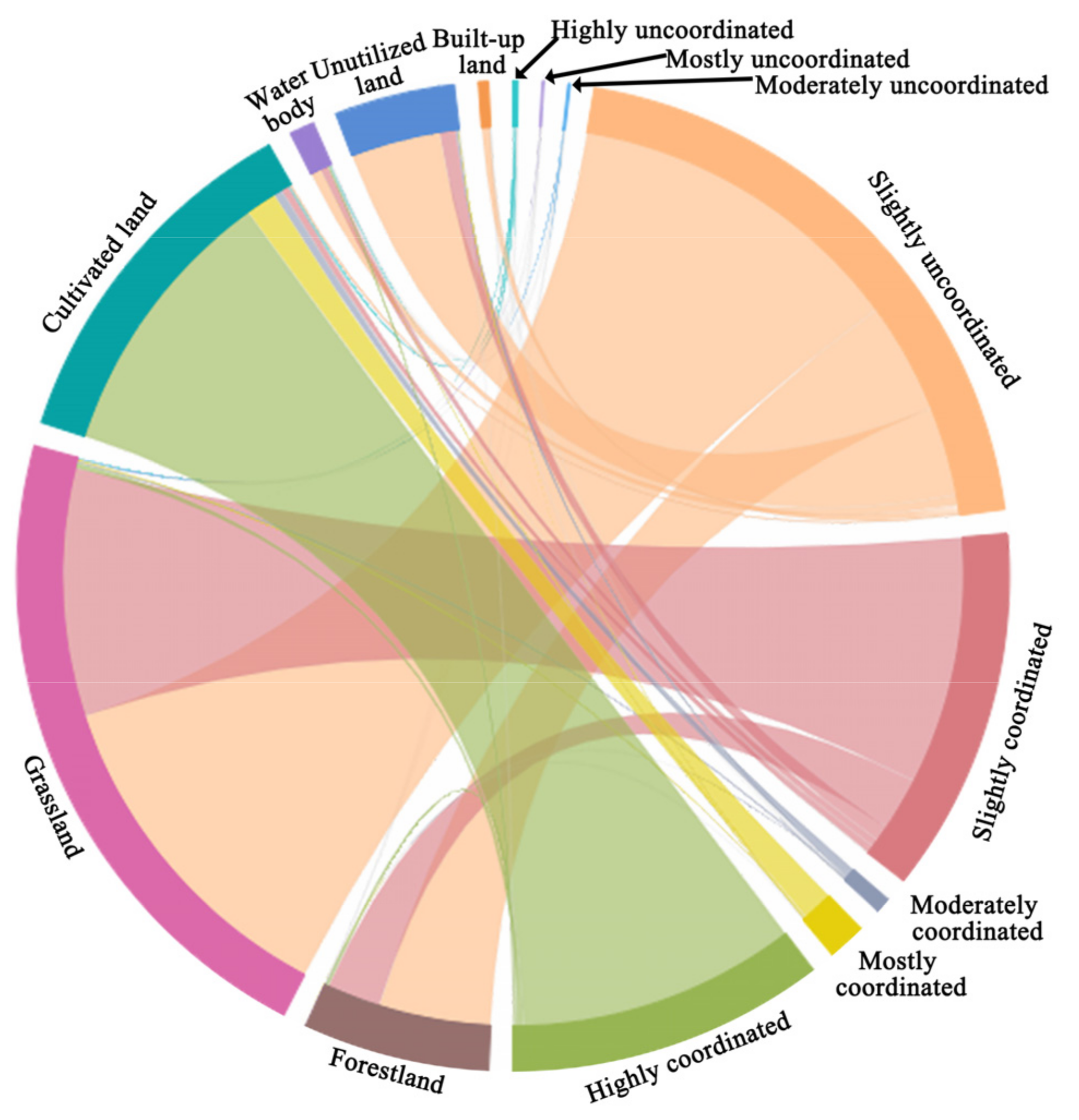
| Service type | Ecosystem Service Value/(yuan·km−2·a−1) | |||||
|---|---|---|---|---|---|---|
| Forestland | Grassland | Cultivated Land | Water Body | Unutilized Land | Built-up Land | |
| Gas regulation | 30.970 | 7.079 | 4.424 | 0.000 | 0.000 | 0.000 |
| Climate regulation | 23.891 | 7.964 | 7.875 | 4.070 | 0.000 | 0.000 |
| Water conservation | 28.315 | 7.079 | 5.309 | 180.332 | 0.265 | 0.000 |
| Soil formation and protection | 34.509 | 17.255 | 12.919 | 0.088 | 0.177 | 0.000 |
| Waste treatment | 11.592 | 11.592 | 14.512 | 160.866 | 0.088 | 0.000 |
| Biodiversity conservation | 28.846 | 9.645 | 6.282 | 22.033 | 3.008 | 0.000 |
| Food production | 0.885 | 2.655 | 8.849 | 0.885 | 0.088 | 0.000 |
| Raw material | 23.006 | 0.442 | 0.885 | 0.088 | 0.000 | 0.000 |
| Entertainment culture | 11.326 | 0.354 | 0.088 | 38.402 | 0.088 | 0.000 |
| Total | 193.340 | 64.065 | 61.143 | 406.764 | 3.714 | 0.000 |
| Province | 2000 | 2005 | 2010 | 2015 | ESVper Rate of Change /% | ||||
|---|---|---|---|---|---|---|---|---|---|
| ESV/ (108 yuan/km2) | ESVper/ (104 yuan/km2) | ESV/ (108 yuan/km2) | ESVper/ (104 yuan/km2) | ESV/ (108 yuan/km2) | ESVper/ (104 yuan/km2) | ESV/ (104 yuan/km2) | ESVper/ (104 yuan/km2) | ||
| Qinghai | 1153.51 | 76.70 | 1174.18 | 78.07 | 1140.00 | 75.80 | 1094.82 | 72.79 | −5.10% |
| Sichuan | 190.35 | 102.78 | 178.05 | 96.14 | 172.71 | 93.26 | 164.35 | 88.72 | −13.68% |
| Gansu | 1088.31 | 76.32 | 1105.04 | 77.49 | 1075.53 | 75.42 | 1369.87 | 96.06 | 25.86% |
| Ningxia | 145.13 | 28.31 | 147.37 | 28.75 | 167.43 | 32.66 | 253.84 | 49.51 | 74.89% |
| Inner Mongolia | 433.06 | 28.72 | 435.61 | 28.89 | 420.05 | 27.86 | 524.97 | 34.82 | 21.24% |
| Shaanxi | 996.06 | 75.06 | 990.45 | 74.64 | 1047.82 | 78.96 | 1387.17 | 104.53 | 39.26% |
| Shanxi | 903.12 | 93.40 | 877.93 | 90.80 | 867.43 | 89.712 | 1144.64 | 118.40 | 26.77% |
| Henan | 313.72 | 86.14 | 302.77 | 83.13 | 301.86 | 82.88 | 458.72 | 125.93 | 46.19% |
| Shandong | 68.72 | 52.99 | 71.78 | 55.36 | 63.90 | 49.28 | 126.49 | 97.57 | 84.13% |
Publisher’s Note: MDPI stays neutral with regard to jurisdictional claims in published maps and institutional affiliations. |
© 2020 by the authors. Licensee MDPI, Basel, Switzerland. This article is an open access article distributed under the terms and conditions of the Creative Commons Attribution (CC BY) license (http://creativecommons.org/licenses/by/4.0/).
Share and Cite
Guo, A.; Zhang, Y.; Zhong, F.; Jiang, D. Spatiotemporal Patterns of Ecosystem Service Value Changes and Their Coordination with Economic Development: A Case Study of the Yellow River Basin, China. Int. J. Environ. Res. Public Health 2020, 17, 8474. https://doi.org/10.3390/ijerph17228474
Guo A, Zhang Y, Zhong F, Jiang D. Spatiotemporal Patterns of Ecosystem Service Value Changes and Their Coordination with Economic Development: A Case Study of the Yellow River Basin, China. International Journal of Environmental Research and Public Health. 2020; 17(22):8474. https://doi.org/10.3390/ijerph17228474
Chicago/Turabian StyleGuo, Aijun, Yongnian Zhang, Fanglei Zhong, and Daiwei Jiang. 2020. "Spatiotemporal Patterns of Ecosystem Service Value Changes and Their Coordination with Economic Development: A Case Study of the Yellow River Basin, China" International Journal of Environmental Research and Public Health 17, no. 22: 8474. https://doi.org/10.3390/ijerph17228474
APA StyleGuo, A., Zhang, Y., Zhong, F., & Jiang, D. (2020). Spatiotemporal Patterns of Ecosystem Service Value Changes and Their Coordination with Economic Development: A Case Study of the Yellow River Basin, China. International Journal of Environmental Research and Public Health, 17(22), 8474. https://doi.org/10.3390/ijerph17228474






